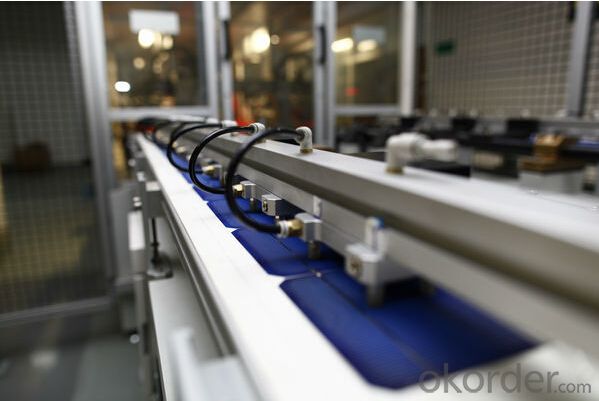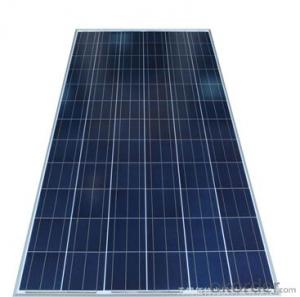Polycrystalline Silicon Solar Panel 255W CNBM
- Loading Port:
- China main port
- Payment Terms:
- TT OR LC
- Min Order Qty:
- 5000 watt
- Supply Capability:
- 200000000 watt/month
OKorder Service Pledge
OKorder Financial Service
You Might Also Like
1.Product Description
Dimension | 156mmx156mm±0.5mm |
Thickness(Si) | 180µm ±20µm, 200µm±20µm |
Front | Blue silicon nitride anti-reflective coatings 1.4mm silver busbar |
Back | Full-surface aluminum back-surface field 2.5mm(silver/aluminum discontinuous soldering pads) |
2.Features
1).High efficiency resulting in superior power output performance
2). Outstanding power output even in low light or high temperature conditions
3).Optimized design for ease of soldering and lamination
4).Long-term stability,reliability and performance
5). Low breakage rate
6) Color uniformity
7).Lowest price
8).Certification: CE,ROHS,IEC,TUV,UL.
9). Prompt delivery
3.Production and Quality Control
1).Precision cell efficiency soring procedures
2).Stringent criteria for color uniformity and appearance
3).Reverse current and shunt resistance screening
4).REACH-SVHC test passed, IS09001,ISO14001 and OHSAS 18001
certificated
5). Calibrated against Fraunhofer ISE
4.Electrical Performance
Efficiency code | 182 | 180 | 178 | 176 | 174 | 172 | 170 | |
Efficiency | Eff(%) | 18.20 | 18.00 | 17.80 | 17.60 | 17.40 | 17.20 | 17.00 |
Power | Ppm(W) | 4.43 | 4.38 | 4.33 | 4.28 | 4.23 | 4.19 | 4.14 |
Max. Power current | Ipm(A) | 8.26 | 8.22 | 8.17 | 8.12 | 8.08 | 8.05 | 7.99 |
Short Circut Current | Isc(A) | 8.71 | 8.68 | 8.63 | 8.60 | 8.56 | 8.53 | 8.49 |
Max. Power Voltage | Vpm(V) | 0.536 | 0.533 | 0.530 | 0.527 | 0.524 | 0.521 | 0.518 |
Open Cirtuit Voltage | Voc(V) | 0.634 | 0.632 | 0.630 | 0.627 | 0.625 | 0.622 | 0.620 |
Efficiency code | 168 | 166 | 164 | 162 | 160 | 158 | 156 | |
Efficency | Eff(%) | 16.80 | 16.60 | 16.40 | 16.20 | 16.00 | 15.80 | 15.60 |
Power | Ppm(W) | 4.09 | 4.04 | 3.99 | 3.94 | 3.89 | 3.85 | 3.79 |
Max. Power Current | Ipm(A) | 7.94 | 7.90 | 7.85 | 7.80 | 7.75 | 7.71 | 7.68 |
Short Circuit Current | Isc(A) | 8.45 | 8.41 | 8.38 | 8.35 | 8.32 | 8.25 | 8.22 |
Max. Power Volgate | Vpm(V) | 0.515 | 0.512 | 0.509 | 0.507 | 0.505 | 0.504 | 0.502 |
Open Circut Voltage | Voc(V) | 0.618 | 0.616 | 0.614 | 0.613 | 0.612 | 0.610 | 0.609 |
5. Solar Panel Images



6.FAQ
1.How about your company?
CNBM Solar photovoltaic (PV) Panel has various wattage from 1.5W to 315W to meet the demand of every customer. It is the optimal choice for both on-grid and off-grid power systems. CNBM Solar panel offers high performance of power warranty and good after sale service, we have professional people to reply your problem anytime.
CNBM International Corporation's products including Monocrystalline Solar Panel, Polycrystalline Solar Panel have received and enjoyed famous reputation in many countries and regions in the world .As a solar panel supplier in China, we strive to provide our customers with excellent service, superior products and unmatched value.
2.How to guarantee the quality of the products?
CNBM Solar performance guarantees for 25 years
• 12 years guarantee for workmanship
• Timeliness of delivery
• Quality Products certified (TÜV, UL, CE, ISO)
3.How long can we receive the product after purchase?
In the purchase of product within three working days, We will arrange the factory delivery as soon as possible. The pecific time of receiving is related to the state and position of customers.Commonly 7 to 10 working days can be served.
- Q:How can I calculate the amount of watts needed for a solar panel to power a water and air pump in gal/hr and a 600 watt LED light?
- Mimi: Solar Power is not really that economical, and has many other disadvantages as well. You did not specify much info in your question as to the size of the water or air pump. So let's make some assumptions to get you some numbers. ) Let's say the water and air pump are about HorsePower (HP). The HP pump , considering efficiency losses, will draw around ,000 Watts , or kW. 2) The 600 Watt LED Light is quite high --- they are usually much smaller lights 40 Watts or less. BTW --- these LED lights are very expensive light as well. Just so you are aware. Between the pump(s) ( maybe 000 to 400 Watts) and the 600 Watt light ----- and without knowing the specifics --- you are probably looking at around 2,000 Watts or 2 kW. A 2 kW Solar PV unit will run around $20,000. The PV unit will only run at full capacity during daylight hours. They usually average about 5 hours per day. So you will only be able to run your pump and LED Lights during the middle of the day --- maybe 0:00 AM to 5:00 PM. If you want to run the pump and lights after sundown, you will need battery back-up. The electric storage batteries will likely run about an extra $5,000. They will last about 5 years. If you decide this doesn't work out well --- you can stay with the local utility --- at $0.0 per kWh. It will cost you about $0.0 per hour to run the pump --- maybe 30 to 50 cents per day. It would cost you about 6 cents per hour to run your light. Maybe 30 or 40 cents per day. You could essentially run your pumps and light several hours each day --- all for about $ per day, or $365 per year. This sounds like a less costly alternative.
- Q:Can solar panels be installed on a historical building?
- Yes, solar panels can be installed on a historical building. However, it is essential to consider the building's architectural significance, structural stability, and local preservation regulations. The installation should be done in a way that respects and preserves the historical character of the building while providing the benefits of renewable energy.
- Q:How much is the cost of solar panels including installation for my home so that I can have low monthly power bills.
- Home systems start at $30,000 and go up. There are federal income tax credits to help offset the cost, but you still have to pay up front, more than the average person can afford.
- Q:I have four power packs for solar lights. They have 3 AA .2volt batteries of 2450 mAh capacity installed in series for a total supply voltage of 4 volt maximum for the lights. I want to charge all four packs at once off a single 6 volt solar panel. With the four packs wired in parallel, what capacity output (wattage) panel do I need to charge the batteries in an 8 hour day?
- 325 mAh+ losses so maybe 3.2Ah to 3.5Ah.
- Q:I was trying to figure out if I could run an electric heater off of a solar panel, but I don't understand these electric convertion factors and stuff. Would it work? (I know it'll only work in the daytime and stuff.)SOLAR PANELPeak Power 95W PTC Watts 73.0WVoc 30.7VPeak Voltage 24.4VIsc 8.6APeak Current 7.96A HEATERInput: 20 V/60 Hz ,500 W/5,200 BTU
- A 500 watt water heater is very small. Most are over 5000 watts. But even a water heater that small would not heat water with a 95 watt solar panel. Inverting the 24 volt to 20 volt would still give you 95 watts of power. A little short of the 500 needed. Sorry. Solar is cool but not practical for large loads unless you install more panels.
- Q:solar panel capacity, how do it work
- You can find a lot on the Internet about how solar panels work. See the links below. I'm not sure how you define capacity. Solar panels are made up of many solar cells. Each cell is capable of generating a low DC voltage while delivering a small current, Several cells are connected in series, making strings to develop the required voltage. Then many of these strings are connected in parallel, so the panel can deliver a usable current. Then the panels are connected in series and/or parallel to deliver a usable voltage and current. My panels are rated at 24 volts. 20 panels are connected in series to develop 480 volts. This is sent to an inverter, which converts the 480 volts DC to 20 volts AC
- Q:Can solar panels be installed on schools or educational campuses?
- Yes, solar panels can be installed on schools or educational campuses. In fact, many educational institutions are increasingly adopting solar energy systems as a sustainable and cost-effective solution for their power needs. Installing solar panels on schools not only helps reduce carbon emissions and reliance on fossil fuels, but also provides educational opportunities for students to learn about renewable energy and its benefits. It can also lower electricity bills and redirect saved funds towards educational programs.
- Q:How do solar panels affect the property's sustainable development goals?
- Solar panels can greatly contribute to a property's sustainable development goals by providing clean and renewable energy. By harnessing the power of the sun, solar panels reduce reliance on fossil fuels, decrease carbon emissions, and promote environmental sustainability. Additionally, the installation of solar panels can lead to long-term cost savings on electricity bills, enhancing economic sustainability. Overall, solar panels play a crucial role in advancing a property's sustainable development goals by supporting both environmental and economic sustainability.
- Q:okay so my teacher is trying to install a solar panel but we have a problem we don't know where to ground it because it will be a movil house. guys do you have any ideas?
- Typically you mount it with the frame as a ground and you ground the frame with a wire or cable tied into the ground when the mobile home is parked.
- Q:Can solar panels be installed on water bodies or reservoirs?
- Yes, solar panels can be installed on water bodies or reservoirs. This type of installation is known as floating solar or floating photovoltaic (PV) systems. By installing solar panels on water bodies, it maximizes the use of space and offers numerous benefits such as reducing water evaporation, increasing energy production due to the cooling effect of the water, and providing an opportunity to repurpose underutilized water surfaces for renewable energy generation.
1. Manufacturer Overview |
|
|---|---|
| Location | |
| Year Established | |
| Annual Output Value | |
| Main Markets | |
| Company Certifications | |
2. Manufacturer Certificates |
|
|---|---|
| a) Certification Name | |
| Range | |
| Reference | |
| Validity Period | |
3. Manufacturer Capability |
|
|---|---|
| a)Trade Capacity | |
| Nearest Port | |
| Export Percentage | |
| No.of Employees in Trade Department | |
| Language Spoken: | |
| b)Factory Information | |
| Factory Size: | |
| No. of Production Lines | |
| Contract Manufacturing | |
| Product Price Range | |
Send your message to us
Polycrystalline Silicon Solar Panel 255W CNBM
- Loading Port:
- China main port
- Payment Terms:
- TT OR LC
- Min Order Qty:
- 5000 watt
- Supply Capability:
- 200000000 watt/month
OKorder Service Pledge
OKorder Financial Service
Similar products
New products
Hot products
Related keywords




























